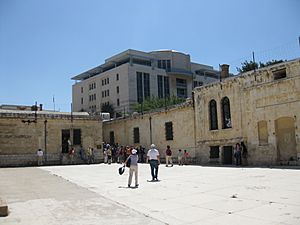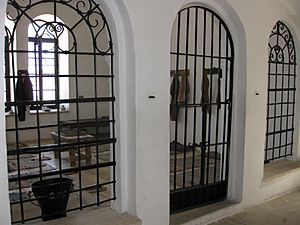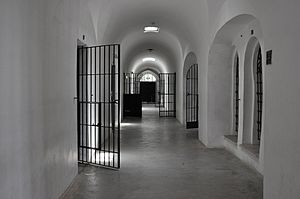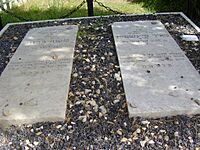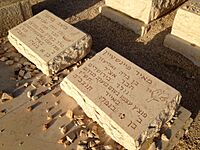Museum of Underground Prisoners facts for kids
The Museum of Underground Prisoners is a museum in Jerusalem. It tells the story of the Jewish underground groups—the Haganah, Irgun, and Lehi—who were active before the State of Israel was created in 1948. The museum is located in a building that was once a prison run by the British.
Contents
History of the Building
The building where the museum now stands has a long and interesting history. It wasn't always a prison.
A Place for Travelers
The building was first built in the late 1800s, when the area was part of the Ottoman Empire. It was part of a larger area called the Russian Compound, which had a church, a hospital, and places for Russian Christian travelers, called pilgrims, to stay. This specific building was a hostel for women. You can still see the Russian words for "Marianskya women's hostel" above the entrance.
A British Prison
In 1917, during World War I, Great Britain took control of the region. The British government turned the Russian Compound into their main center for security and government. The women's hostel, with its long hallways and many small rooms, was turned into the main prison in Jerusalem.
For about 30 years, hundreds of prisoners were held here. This included members of the Jewish underground groups who were fighting for an independent Jewish state. These groups carried out attacks against the British, and their members were often arrested. The British guards would sometimes tell the Jewish prisoners, "What you start on the outside, you finish on the inside," because they were forced to make coffins for British soldiers who had been killed in the attacks.
The prison was heavily guarded with wire fences and bars. The sign on the door, "Central Prison Jerusalem," is from that time.
Becoming a Museum
The British control, known as the British Mandate, ended in May 1948. During the 1947–1949 Palestine war, Jewish forces captured the compound. After Israel became a country, the building was used for different things, like storage.
In 1991, the Israeli Ministry of Defense took over the building. They restored it to look like it did when it was a prison and opened it as the museum it is today.
Life in the Prison
The British had a system of courts and prisons across the land. Members of the Jewish underground were considered "political prisoners" and were tried in military courts. Their sentences could be anything from a few months in jail to life imprisonment or even death.
At first, Jewish and Arab prisoners were kept in the same cells. But as more underground members were imprisoned, they demanded to be kept separately. The British agreed, and the prison was divided into a Jewish wing and an Arab wing. Despite the conflict happening outside, relations between Jewish and Arab prisoners were often peaceful.
What's Inside the Museum?
The museum shows what life was like for the prisoners. Many exhibits are set up in the original rooms of the prison.
Prisoner Cells
In the cells, you can see the simple brown clothes prisoners wore and the thin mats they slept on. Each cell had a bucket that was used as a toilet. One prisoner in each cell was chosen as the "mukhtar," or supervisor, and was given a real bed to sleep on.
The Escape Room
In 1948, members of the Irgun and Lehi planned a daring escape. In one of the cells close to the outer fence, they dug a tunnel. The tunnel connected to a sewer pipe that went under the fence. With help from friends on the outside who pretended to be city workers, 12 prisoners escaped and rejoined the fight for Israel's independence.
The Synagogue Room
One cell was used as a synagogue on Shabbat and Jewish holidays. This room is connected to the story of Rabbi Aryeh Levin, who was known as "the father of the prisoners." For 25 years, he visited the prison every week to bring comfort and encouragement to the Jewish prisoners.
Workshops
Prisoners had to work in workshops. They did carpentry, printing, and sewing. The British used these workshops to make things they needed, like coffins for their soldiers.
Solitary Confinement
Prisoners who broke the rules were punished by being put in tiny, dark cells called "hell." They could be kept there for a few hours or up to two weeks.
The Story of Feinstein and Barazani
The most famous story from the prison is about two young men, Moshe Barazani of the Lehi and Meir Feinstein of the Irgun. In 1947, they were sentenced to death by the British.
The British planned to execute them in Jerusalem. To prevent this, the underground groups smuggled two small, homemade grenades into their cell, hidden inside oranges. The plan was for the men to use one grenade on their executioners and the other on themselves.
However, they learned that a rabbi, Yaakov Goldman, planned to be with them at the execution. Not wanting to harm him, they changed their plan. On the night before their scheduled execution, April 21, 1947, they held the grenade between them, sang Hatikvah (Israel's future national anthem), and detonated it. They died together, and their story became a powerful symbol of sacrifice.
Outside the Museum
In the courtyard of the museum, you can see the original gravestones of Moshe Barazani and Meir Feinstein. They were first buried on the Mount of Olives. Menachem Begin, the former commander of the Irgun who later became Prime Minister of Israel, asked in his will to be buried next to them.
See also
- Sde Teiman detention camp


